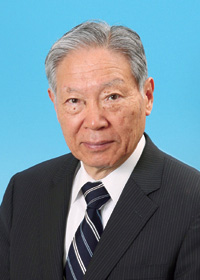
 President Shojiro MATSUURA |
We sincerely thank you for your understanding and continued support of our research and development activities. Since the foundation of the Japan Atomic Energy Agency (JAEA), this publication has been brought out every year with the intention of informing you of the day-to-day accomplishments of the JAEA.
As the only research institute in Japan dedicated to comprehensive nuclear research and development, JAEA has focused on investing efforts toward the recovery from the accident at the Tokyo Electric Power Company, Incorporated (TEPCO) Fukushima Daiichi Nuclear Power Station (NPS) by our scientific and technical expertise.
Furthermore, JAEA could not prevent the occurrence of a series of incidents, such as inadequate maintenance management at the “Monju” and leakages from the Hadron Experimental Facility of Japan Proton Accelerator Research Complex (J-PARC). JAEA is endeavoring to recover the public’s trust by improving ourselves. JAEA defined the year beginning October 2013 as an intensive organizational reform period, all JAEA united in an effort to achieve the necessary reform. With strong resolution to recreate ourselves anew, we have made efforts to enhance corporate planning functions, safety management functions, and internal control mechanisms, including reorganizing our research and development framework into six departments. For “Monju,” we established an independent management system for the power plant and enhanced the quality assurance system. As part of the J-PARC reforms, we equipped the facilities with safety management systems to guarantee safety.
In April 2014, the “Strategic Energy Plan” was approved by the Cabinet, and the position of nuclear power was designed in the Plan as “a crucial base-load power source, contributing to stability of the energy supply and demand structure” in Japan. In addition, it was expressed in the “Basic Policies for the Economic and Fiscal Management and Reform 2014,” approved by the Cabinet in June 2014.
For research and development related to the decommissioning of the TEPCO’s Fukushima Daiichi NPS, we have promoted the test on the characterization of the fuel debris, remote decontamination technology, the long-term integrity of the fuel assembly in the spent fuel storage pool for the preparation of its removal, and the treatment and disposal of radioactive waste caused by the accident. We have performed research and development activities towards the quick return of the residents such as radiation monitoring in forests and rivers, migration of radioactive cesium, and calculation of decontamination effects. In addition, we are making efforts to contribute to the recovery from the accident by developing improved decontamination materials, etc.
In the research and development of the fast breeder reactor cycle technology, including “Monju” we aim to collect the research results stipulated in the “Monju Research Plan,” and are working towards lifting the security measures put in place by the Nuclear Regulation Authority and complying with the new regulation standards. We are also conducting a research and development activities about reduction and stabilization of radioactive wastes, as well as transmutation technology using accelerators.
Moreover, for the activities on the backend of nuclear energy utilization, which are necessary for advancing our project, we have performed research and development on decommissioning of our own facilities, and the treatment and disposal of radioactive waste. We are also moving forward with the development of technologies related to the processing and disposal of low-level radioactive waste, underground disposal and the light-water reactor fuel cycle.
Regarding nuclear hydrogen and heat application, we are making steady progress in research and development efforts to improve the safety of high-temperature gas-cooled reactors. Furthermore, we aim to conduct trials that connect a High-Temperature engineering Test Reactor (HTTR) with heat utilization facilities (gas turbine power generation, hydrogen production, etc.) as a step toward the practical application of high-temperature gas-cooled reactors. In the research and development aimed at the practical utilization of nuclear fusion energy, we, as a domestic agency/implementing agency of Japan under roles based on the international framework (ITER Project/BA activity) have been promoting our operations using the world’s most advanced technologies along the plan that the JAEA prescribed. As part of the research and development on quantum beam science, we have been producing a variety of results in areas ranging from the fundamentals of science and technology to industrial applications, through various quantum beam facility groups owned by the JAEA. Moreover, we have recognized that ensuring nuclear safety is an important step in the use of nuclear power, and we have diligently conducted nuclear safety research for the improvement of safety in the utilization of nuclear energy. In addition, we have promoted a wide variety of engineering research activities, which will serve as the basis in the development of nuclear energy utilization in Japan; these activities have led to many accomplishments.
Hereafter, we are steadily proceeding with structural reforms in accordance with the plan that the JAEA has set forth. With the increased expectations toward the JAEA’s role in nuclear technology development after the accident at the TEPCO’s Fukushima Daiichi NPS, we are now actively involved in medium-to-long-term human resource development for nuclear technology, industry–academia–government collaborations, promotion of international cooperation with overseas research institutes, and the dissemination of the achievements made in research and development, without failing to prioritize operations.
We are pleased that you will gain further understanding of the accomplishments of the JAEA through this publication, and we thank you for your continued encouragement and guidance in our research and development activities.
Next: About This Publication and the Outline of Organization of JAEA>